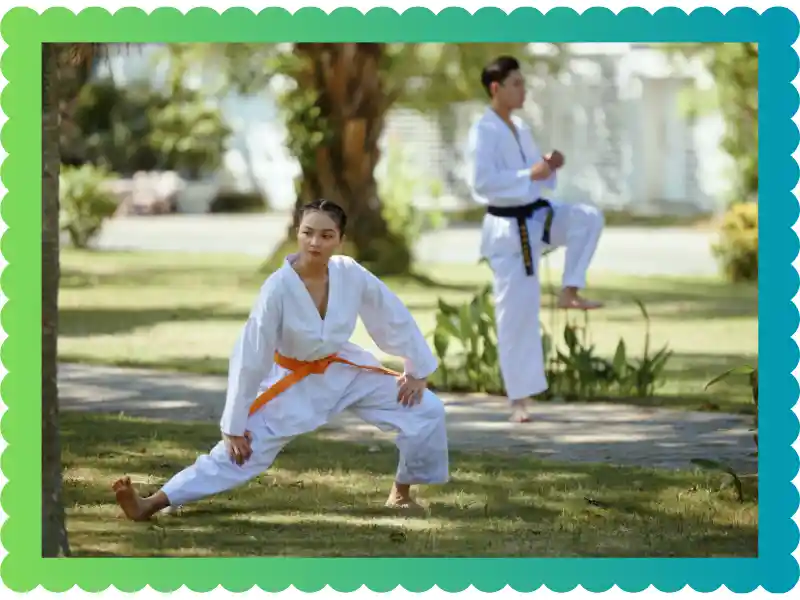
You know that feeling when you’re pumped to kick some pads, but your instructor makes everyone do stretches first? I used to think warm-ups were a waste of time. Then I pulled my hamstring during a roundhouse kick. Trust me, that changed everything. A proper taekwondo warm up routine isn’t just about touching your toes. It’s about preparing your body for the explosive movements, high kicks, and quick pivots that make martial arts so powerful.
At Taekwondoking, we’ve seen countless students avoid injuries simply by taking those first 10-15 minutes seriously.
Why Warming Up Matters in Taekwondo
Your muscles are like rubber bands. Cold rubber snaps. Warm rubber stretches. Simple as that.
Taekwondo demands incredible flexibility and power. You’re throwing head-height kicks, spinning, and moving in ways your body doesn’t do during daily life. Without warming up, you’re asking for trouble.
Studies show that proper warm-up exercises reduce injury risk by up to 50%. In dojangs across the United States, we’re seeing fewer pulled muscles and joint injuries when students commit to a structured warm up routine.
See the latest Top-Rated Adjustable Dumbbells Set Price Today Used by Champions.

Dynamic Stretching vs Static Stretching: What Works Better
Here’s something most beginners get wrong. They sit on the floor and hold stretches before training starts. That’s static stretching, and it actually reduces your power output when done cold.
Dynamic stretching involves movement. You’re actively moving your joints through their full range while increasing blood flow. This prepares your muscles for action instead of relaxing them.
Save static stretches for your cool-down. During your taekwondo warm up routine, keep everything moving. Your kicks will thank you.
The Perfect 15-Minute Taekwondo Warm-up Routine
Let me walk you through what we do at Taekwondoking before every class. This routine covers everything from your neck to your ankles.
Light Cardio to Raise Your Heart Rate (3 minutes)
Start with easy jogging around the mat. Your goal is to raise your body temperature and get blood flowing to your muscles. You should feel slightly warm but not tired.
Add some side shuffles and backward jogging. Mix in arm circles while you move. This gets your whole body involved right from the start.
Neck and Shoulder Mobility (2 minutes)
Neck rolls feel amazing after sitting at a desk all day. Roll slowly in both directions. No jerky movements.
Do arm swings forward and backward. Make big circles. Your shoulders carry tension, especially if you work at a computer. Loosen them up before throwing punches.
Hip Circles and Leg Swings (3 minutes)
Your hips are everything in taekwondo. Every kick starts there.
Stand on one leg and swing the other forward and back. Start small, then go higher as you warm up. Do 10-15 swings each leg. Then switch to side-to-side swings.
Hip circles wake up those smaller stabilizer muscles. Make big circles with your knee raised. Both directions. Both legs.
Dynamic Leg Stretches (4 minutes)
Walking lunges are perfect for martial artists. Take a step, drop your back knee, then push up and step again. Keep your torso upright. Do 10 on each leg.
Walking knee raises bring your knee to your chest with each step. This mimics the chamber position for front kicks and roundhouse kicks.
Leg cradles look funny but work wonders. Lift your knee, then grab your shin and pull it across your body toward your opposite shoulder. Alternate legs as you walk.
Specific Taekwondo Movements (3 minutes)
Now your body is ready for technique-specific movements. Do slow front kicks, focusing on proper form rather than speed or height. Gradually increase the height as your muscles respond.
Add some slow roundhouse kicks and side kicks. Practice your stances with transitions. Do some quick footwork drills.
This bridges the gap between general warm-up and actual training. Your mind starts focusing on technique while your body finishes preparing.
Common Warm-up Mistakes That Lead to Injuries
I’ve been teaching at Taekwondoking for years. These mistakes happen in almost every beginner class until we correct them.
Rushing Through the Process
Ten minutes feels like forever when you want to start sparring. But rushing means cold muscles trying to perform hot movements. That’s when hamstrings pop and ankles roll.
Your warm up routine should gradually increase intensity. Don’t go from zero to full-power kicks in five minutes.
Skipping Lower Body Focus
Taekwondo is leg-intensive. Yet some students spend all their warm-up time on upper body movements. Your legs need the most attention.
Spend at least 60% of your warm-up on hips, hamstrings, quadriceps, and ankles. These areas take the most stress during kicks and stances.
Bouncing During Stretches
Ballistic stretching means bouncing to force a deeper stretch. This triggers the stretch reflex, where your muscles contract to protect themselves. You’re fighting against your own body.
Keep all movements smooth and controlled during your taekwondo warm up routine. Gradual progression beats forcing anything.
Training on Cold Muscles in Winter
Here in the States, many dojangs get chilly during winter months. Your body needs extra warm-up time when the room temperature drops.
Add 3-5 minutes to your routine during cold weather. Wear layers you can remove as you heat up. Cold muscles tear easier than warm ones.
Age-Specific Warm-up Adjustments
Not everyone needs the same warm up routine. A 20-year-old athlete and a 50-year-old practitioner have different needs.
Kids and Teens
Young students are naturally flexible but lack body awareness. Their warm-ups should focus on coordination and control rather than intensity.
Make it fun. Kids respond better to games that incorporate warm-up movements. “Kick the imaginary balloon” works better than “do 10 front kicks.”
Adults Over 40
Our older students at Taekwondoking need more time to warm up properly. Joints are stiffer. Old injuries need extra attention.
Spend more time on mobility work. Add gentle joint rotations for knees and ankles. Listen to your body every single class.
If something feels tight, spend extra time there. Don’t compare yourself to the 25-year-old next to you. Your journey is yours.
Injury Prevention Beyond Warm-ups
Your taekwondo warm up routine is just one piece of injury prevention. Other factors matter too.
Proper Technique Always Comes First
Bad form causes more injuries than skipped warm-ups. A perfectly executed kick with proper alignment rarely causes injury. A sloppy kick can wreck your knee even when warm.
Work with instructors who emphasize technique over power, especially when learning new movements. Speed and strength come after form is correct.
Know When to Rest
American culture often pushes “no pain, no gain.” That’s nonsense when it comes to martial arts training. Pain is your body’s warning system.
Sharp pain means stop immediately. Muscle fatigue is normal. Joint pain is not. Take rest days seriously. Your body grows stronger during recovery, not during training.
Conditioning Outside the Dojang
Your warm up routine prepares you for class. But general fitness makes everything safer. Stronger muscles protect joints better. Better cardiovascular health means less fatigue-related injuries.
Add some strength training and cardio work outside taekwondo practice. You don’t need a fancy gym. Bodyweight exercises and jogging work great.
See the latest Top-Rated Adjustable Dumbbells Set Price Today Used by Champions.

Creating Your Personal Warm-up Checklist
Everyone’s body is different. Maybe your ankles need extra attention. Perhaps old shoulder injuries require specific movements.
Start with the basic 15-minute routine I outlined. Then adjust based on your needs. Keep what works. Modify what doesn’t.
Write it down. A physical checklist helps you stay consistent, especially during early morning classes when your brain isn’t fully awake yet.
At Taekwondoking, we encourage students to develop their personalized pre-class routine. You know your body better than anyone else.
The Mental Benefits of a Consistent Warm-up
Here’s something nobody talks about enough. Your taekwondo warm up routine creates a mental transition from daily life to training mode.
Those 15 minutes become a ritual. Work stress fades. Family concerns take a backseat. Your mind focuses on the present moment and the training ahead.
This mental preparation is just as important as physical readiness. You enter your first drill with clear focus instead of scattered thoughts.
Final Thoughts on Building Better Habits
Look, I get it. Warm-ups aren’t the exciting part of martial arts. Nobody watches YouTube videos of professional fighters doing hip circles.
But every single elite athlete in every sport follows a structured warm-up protocol. They understand that consistent preparation leads to better performance and longer careers.
Your taekwondo journey should last decades, not months. Protecting your body through proper warm-up exercises is how you make that happen.
Start tomorrow. Arrive 15 minutes early. Go through the full routine. Notice how your kicks feel higher and smoother. Pay attention to how your body responds.
After a few weeks, this becomes automatic. You won’t need to think about it. Your body will crave that preparation time. And years from now, when your training partners are nursing old injuries, you’ll still be throwing head-height kicks because you built smart habits today.
That pulled hamstring I mentioned at the start? Never happened again after I started taking warm-ups seriously. Now every student who trains with us learns this lesson without paying the painful price I did. That’s what we do here at Taekwondoking – share the wisdom so you can skip the hard lessons.
Train smart. Stay consistent. Keep kicking.
FAQs
The 12/8-4 is likely a set and rep scheme used in strength training. It means you do the exercise for 12 reps, then 8 reps, and finally 4 reps. The weight is increased with each drop in reps.
The 5-3-1 rule is a popular strength training program by Jim Wendler. It uses set and rep numbers for lifts like the squat and deadlift. It focuses on slow, steady gains in strength.
A 2-4-4 warm-up is a specific routine, possibly for sports or group fitness. The numbers likely refer to the time or repetitions for different warm-up parts. For example, 2 minutes of light cardio followed by 4 minutes of dynamic stretching.
The 4-8-12 rule is a strength training technique, like the 12/8-4 rule. It is a drop set where you perform 4 reps, then 8 reps, and finish with 12 reps. The weight is lowered for each set.
Yes, the 12/3/30 treadmill workout can work for fitness and weight loss. It involves walking on an incline of 12 at a speed of 3\text{ mph} for 30 minutes. It is a good cardio exercise.
12 reps 4 sets means you will perform the exercise 12 times in a row. You will then rest and repeat this sequence four times in total.
Start with light cardio like running in place or jumping jacks for 5 minutes. Then do dynamic stretches like leg swings and torso twists. Finish with moves specific to Taekwondo, like light kicking.
Five common warm-up exercises are jumping jacks, arm circles, high knees, leg swings, and torso twists. These moves prepare your whole body for exercise.
The five stages of a warm-up are often defined as light aerobic exercise, dynamic stretching, sport-specific movements, main activity, and cool-down.
This is likely true. Bench pressing 225 pounds is a very high lift for a general population. Only a small fraction of people regularly strength train or are strong enough to lift that much weight.
See the latest Top-Rated Adjustable Dumbbells Set Price Today Used by Champions.


Founder, Owner, and CEO of TaekwondoKing.
He is one of the top 100 martial artists in the World and among the top 20 referees in Bangladesh.
Ehatasamul Alom is an esteemed Kukkiwon Certified Taekwondo 3rd Dan Black Belt with over 15 years of experience in this dynamic martial art. Born in Rajshahi, Bangladesh, Ehatasamul’s journey with Taekwondo began at the tender age of seven. His passion led him to compete at national and international levels, where he has bagged numerous awards and honors. He is also a member of the Taekwondo National Referee Panel.
With a Bachelor’s degree in Sports Science from the prestigious Rajshahi University, Ehatasamul has a deep understanding of the technical and scientific aspects of martial arts and some other martial arts.
In 2022, Ehatasamul created the “TaekwondoKing.com” to share his knowledge, Free Resources, Values, and Real experiences. His articles focus on Taekwondo training techniques, competition strategies, Sport Products Reviews, and the art’s rich history and philosophy. He also writes about the importance of mental fortitude and discipline, key aspects of his teaching philosophy. He has already launched many sports, Taekwondo, and health-related Free online tools. His goal is to inspire both beginners and seasoned practitioners worldwide through insightful and engaging content.
If you need any help, contact Ehatasamul Alom at any time.




